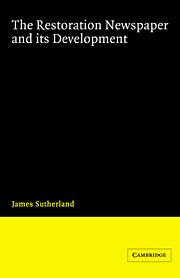1 - Origins and developments
Published online by Cambridge University Press: 07 October 2009
Summary
When Charles II returned from exile in 1660, the general air of rejoicing prompted a burst of confidence from John Dryden:
At home the hateful names of Parties cease
And factious Souls are weary'd into peace.
But this was either wishful thinking, or an early example of that loyalist propaganda he was later to practise so successfully as poet laureate. The real state of affairs was different. As new laws were put into force and government control was steadily tightened, opposition inevitably increased, and equally inevitably, was driven underground. In such circumstances resistance was still possible; the discontented, the dispossessed, the persecuted and the fanatically faithful believers in ‘the Good old Cause’ could still find men who dared to print, and others to disperse, their seditious pamphlets. The risks were great and the penalties heavy, but in the early 1660s such pamphlets kept appearing in considerable numbers, and fostered the spirit of opposition to the restored monarchy. The government had foreseen this danger, and in November 1660 the old Cavalier journalist, Sir John Berkenhead, had been appointed official licenser for the press; but he could only deal with such manuscripts as were submitted to him. More effective was another old royalist, Roger L'Estrange, who, on 24 February 1662, became ‘Surveyor of the Presses’ by virtue of a warrant from Sir Edward Nicholas, one of the two Secretaries of State.
- Type
- Chapter
- Information
- The Restoration Newspaper and its Development , pp. 1 - 43Publisher: Cambridge University PressPrint publication year: 1986



